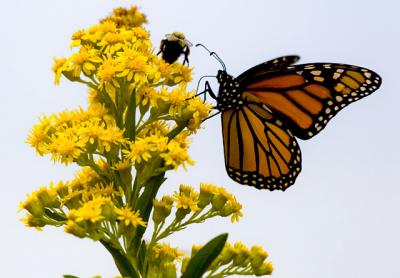Nature Notes: A Marvelous Migration

Fall rolls on. It appears to be more like past autumns in the new millennium, except the fall of 2017, when the leaves stayed on the trees until December and forsythia, which normally blooms only in the spring, bloomed in the last half of November.
It has been a so-so year for wildflowers. Milkweeds were one of the few of our common wild herbs that bloomed well but went to seed exceedingly fast. If it weren’t for these sappy plants, how would monarch butterflies fare locally? Not well at all. They did better than last year, and last year was better than the year before.
Fall is when monarchs have finished up for the season and have begun to migrate south, some 2,000 miles or more, all the way to their favorite overwintering spot in the conifers not too far from Mexico City. Many of those conifers have been cut down in this century and so there is less space for the monarchs than in the last century. Nevertheless, despite having drastically reduced numbers in this century, they are hanging on and may even be increasing in numbers slightly with each new year.
Most of the monarchs that breed here, as well as the ones that fly south across Long Island Sound, continue their journey steering west along the beaches and dunes that make up the our Atlantic Coast. Their numbers increase as they pile up in the Rockaways and Staten Island before heading south. A week ago, Lois Markle, who lives in Hither Woods in Montauk, walked down to the shore and watched as one monarch after another passed by from east to west as they began to traverse the Napeague isthmus. They were all migrating.
Our adult monarchs normally live only a few months after emerging from their cocoons. However, this last batch of the year lives much longer; they have to make it down the coast and ultimately into Mexico where they settle down for the winter clinging to the branches of pines and other conifers. The glycoside poisons from milkweeds and dogbanes that they accumulated as larvae protect them from most would-be predators. However, they also need nutrition.
If they didn’t drink nectar on flowers along the way, they would run out of steam and never make it. So they need late-flowering plants to feed on, and these are mostly flowers of the sunflower family, particularly asters and goldenrods, particularly the seaside goldenrods, Solidago sempervirens. As their scientific name implies, they seem to be the most faithful with respect to flowering each year, and they are the last to flower. Thus, they provide sustenance all the way to the end of October.
If you took a walk along the Atlantic Coast from Montauk Point to Brooklyn at this time, you would see thousands upon thousands of seaside goldenrods in bloom and luckily so. The other goldenrods, including a few species that bloom in July, such as the early goldenrods, Solidago juncea, in my yards, didn’t get much rain and performed poorly this summer. The asters have performed even worse.
Thank God, however, the seaside goldenrods have bloomed marvelously, if a little late, and the monarchs migrating along our shores will have plenty to eat. During daylight hours, if you go to the ocean beaches on either side of the Shinnecock Canal, you will see monarchs flying along and stopping to drink nectar now and then. If you go farther west, say to the Fire Island National Seashore, you will see even more monarchs. Travel to New Jersey and you may see clouds of monarchs, especially at the state’s southernmost terminus, Cape May, where you just might find that there are too many to count. Get the picture?
Now for the question of the day: Which came first, the seaside goldenrod or the monarchs? Let me know if you find out.
Larry Penny can be reached via email at [email protected].
